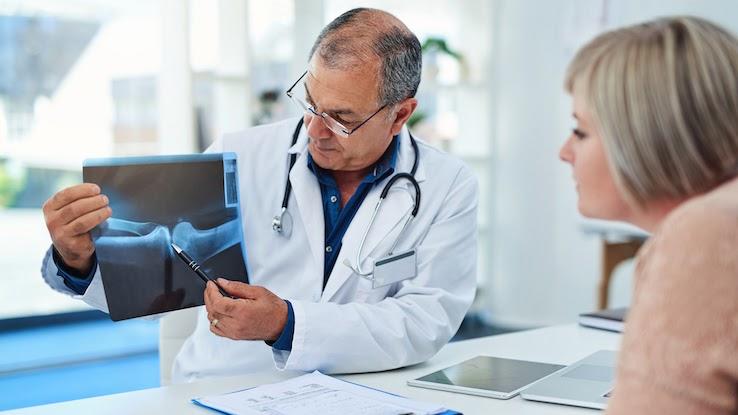Boswell Pain Physician a Systematic Review of Therepeutic Facet Joint

Cartilage — the smooth, ultra-lubricated ends that contact as yous motility your hips, knees, shoulders, fingers and other joints — permits the shine motion of all of the joints of your body. Over time, as a result of athletic action, injuries, work and normal utilise, cartilage can wear down, somewhen leading to pain and inflammation that occur due to the release of cell-signaling molecules from the degrading cartilage.
While this inflammation is a sign of significant cartilage wear, your cartilage may have been thinning for years before y'all get-go to feel the bodily hurting of bone meeting bone, says Richard Diana, G.D., an orthopaedic surgeon and clinical instructor of orthopaedics at Yale-New Haven Hospital in Connecticut. Still, you shouldn't assume that any and all articulation pain is osteoarthritis — "There are more than than 100 kinds of arthritis," says Diana. Pain, weakness or stiffness may betoken other issues, as well, such as a gradually fraying musculus, an autoimmune disease like lupus or an infection like Lyme disease, he adds.
If y'all accept joint hurting that's severe despite the use of over-the-counter anti-inflammatories like ibuprofen and that pain is limiting your normal twenty-four hours-to-day role, information technology'due south essential to get checked by your primary care practitioner or an orthopaedic doctor. During the process of obtaining a diagnosis, you lot can expect to undergo testing, questioning and a variety of procedures that'll help your md fully make up one's mind what's causing your pain.
Questions Your Orthopaedist May Ask
If y'all're experiencing joint pain, your primary care physician may refer you to a specialist chosen an orthopaedist. This is a type of dr. who focuses on treating your musculoskeletal arrangement, which encompasses your basic, joints, tendons and ligaments. Orthopaedists often care for people who accept osteoarthritis, which is the nigh common type of arthritis, but proceed in heed that your articulation hurting may not be the result of arthritis and your healthcare practitioner volition need to get together some data from y'all before performing any diagnostic tests. "An orthopedist is similar Sherlock Holmes trying to figure out if you lot have a mechanical trouble or osteoarthritis," Diana says. The clues will emerge during your exam, and you lot can expect your doctor to ask you these key questions:

Family History: What is your family history? Did either parent have arthritis? Practise whatever siblings take joint bug?
Osteoarthritis and many autoimmune joint conditions, such as rheumatoid arthritis or lupus, run in families. If a parent has a particular type of joint condition, there'due south a pregnant adventure that y'all'll besides develop it. Your doc can evaluate this using radiographs and lab tests. Your physician will also ask you if any of your parents or siblings have needed joint replacements.
Injury and Activity History: What is your personal history with injuries? Did y'all e'er hurt your bones or joints as a child? (An early on injury is often a setup for osteoarthritis subsequently 50, says Diana.) Are y'all a lifelong jogger or a marathon runner? What types of practice do y'all exercise on a regular ground? What do/did you lot do for piece of work?
While osteoarthritis can be the consequence of normal day-to-mean solar day habiliment and tear, injuries yous endure while playing sports or working can often start or accelerate this status or exacerbate joint pain. These injuries may take happened years before your symptom onset. Telling your medico about whatsoever prior surgeries in or around the afflicted joints is also important.
Pain Sensations: What does your pain feel like? Is it sharp and astringent or slow and achy? When exactly does the discomfort beginning, and when does it get worse? Does the contrary joint — the other shoulder or knee joint — hurt likewise? Did these symptoms come up on gradually, or were they sudden? Is the pain worse after activity or rest?
While arthritis tin nowadays with unlike symptoms for each person, the timing of symptoms and the number of joints involved can provide important clues virtually your underlying diagnosis.
Diagnostic Tests for Chronic Joint Pain and Osteoarthritis
In diagnosing any type of arthritis or joint pain, your healthcare practitioner will want to consider the possibility of other causes get-go. There's a wide multifariousness of tests they may order to rule out other weather condition and diagnose arthritis. These include:

- A complete blood count: This measures the number of different types of claret cells you have. It also indicates your general health and the presence of inflammation or infection.
- Erythrocyte sedimentation rate: When inflammation crops up anywhere in your torso, cherry-red blood cells clump together readily (at a higher charge per unit) than normal. A loftier "sed rate" is nonspecific — meaning it as well increases in many other conditions — but it can exist suggestive of an inflammatory arthritis like rheumatoid arthritis and systemic lupus erythematosus, or Lyme disease.
- Antibody claret test: Upwardly to 80% of people with rheumatoid arthritis have an antibody called rheumatoid factor in their claret. More than 95% of people with lupus have antinuclear antibody in their bloodstreams.
- Arthrocentesis: This test involves manually removing fluid from a articulation using a needle so examining that fluid under a microscope. It helps identify infection and can determine if the pain is due to gout, another type of arthritis status.
- Radiography: An 10-ray shows doctors a few things, including how basic of the joint line up; whether the ends are smooth and rounded or accept an unevenness, chosen a os spur; and if a salubrious corporeality of infinite remains between the ends of your basic for cushioning. "X-ray is the least expensive, nearly readily available and valuable tool for detecting moderate osteoarthritis," Diana says.
- Ultrasonography: An ultrasonography, or ultrasound, uses high-frequency audio waves to create an image of soft tissues similar tendons, muscles, ligaments and fretfulness. Different other imaging techniques, this allows your specialist to actually meet these structures as you movement the joint so they tin assess how the articulation is performing, forth with the extent of the damage to structures other than os.
- Computed tomography (CT) scan: These computerized Ten-ray images bear witness vertical and horizontal cantankerous sections of muscle and bone. These "slices" of tissue are much more than detailed than standard X-rays.
- MRI. Using powerful magnets and radio waves, a computer generates an image of basic and surrounding soft tissue. Your medico can see very small details of cartilage degeneration on an MRI. "It'll help detect early on stages of osteoarthritis that may not yet be evident on an 10-ray," says Diana.
How Do Doctors Treat Osteoarthritis?
Non-operative management is the mainstay for handling of mild to moderate osteoarthritis. This means that your md volition want you to try lifestyle and other less-invasive changes to lessen the severity of your arthritis symptoms before pursuing surgery. Your physician is likely to give y'all home exercises or refer you for physical therapy. Injections of steroids or joint lubrication (hyaluronic acid) solutions are commonly recommended, and your doctor can administer them at three- or vi-month intervals without posing whatsoever meaning risk to your joint.

Preserving muscle mass and your ability to engage in normal activities is essential for preventing symptom progression. While you may need to modify some of your routines to avoid certain activities — like heavy lifting, throwing or running, depending on what joints are involved — low-impact exercises such as pond, using an elliptical car, bicycling and walking are ofttimes recommended.
If your medico identifies a problem inside your joint (such as with your meniscus in your knee) or if your arthritic hurting progresses to the point that its normal functioning is significantly compromised, you lot may be a candidate for a surgical procedure. Surgeries for degenerative joint affliction mostly fall into two categories: arthroscopy and arthroplasty.
Arthroscopy involves a surgeon inserting a small telescopic and shaver into your articulation through small incisions. This is a very versatile type of surgery that doctors can use to diagnose and manage cartilage tears, ligament injuries, meniscus tears (if your arthritis is in one or both knees) and, in some cases, significant inflammation. It can be peculiarly useful when X-rays and other types of imaging aren't comprehensive enough to lead to a diagnosis. The risks of this surgery are rather low due to its minimally invasive nature, and you lot're often permitted a total return to normal activities shortly later on your procedure.
Arthroplasty, or full joint replacement, is the but true "cure" for osteoarthritis in a specific joint, only this is a major procedure. Because of this, it'due south usually reserved for severe cases that significantly limit a joint'south ability to role properly. There are many different types of arthroplasty procedures, each indicated for a different blazon of articulation and type of wear that happens to the joint. Your orthopaedic surgeon will speak to you lot at length about what procedures are potentially the most useful for the arthritis you have and the ways it'south afflicted your body.
Resource Links:
- https://www.mayoclinic.org/tests-procedures/arthroscopy/about/pac-20392974
- https://www.mayoclinic.org/diseases-weather/arthritis/in-depth/arthritis/fine art-20047971
- https://world wide web.versusarthritis.org/about-arthritis/treatments/drugs/ibuprofen/
- https://healthcare.utah.edu/orthopaedics/specialties/what-is-orthopedic-doctor.php
- https://www.arthritis.org/wellness-wellness/virtually-arthritis/understanding-arthritis/when-joint-pain-means-its-time
- https://www.arthritis.org/wellness-health/about-arthritis/agreement-arthritis/diagnosing-arthritis
- https://world wide web.lupusresearch.org/agreement-lupus/diagnosis-and-treatment/ana-testing/
- https://www.urmc.rochester.edu/encyclopedia/content.aspx?contenttypeid=167&contentid=rheumatoid_factor
- https://world wide web.hopkinsmedicine.org/health/treatment-tests-and-therapies/arthritis-diagnosis
- https://orthop.washington.edu/patient-care/articles/arthritis/lab-tests-and-arthritis.html
- https://www.mayoclinic.org/diseases-conditions/osteoarthritis/diagnosis-treatment/drc-20351930
- https://world wide web.hopkinsmedicine.org/health/treatment-tests-and-therapies/arthroplasty
lopezdremetweithe.blogspot.com
Source: https://www.symptomfind.com/healthy-living/how-osteoarthritis-joint-pain-diagnosed?utm_content=params%3Ao%3D740013%26ad%3DdirN%26qo%3DserpIndex
0 Response to "Boswell Pain Physician a Systematic Review of Therepeutic Facet Joint"
Post a Comment